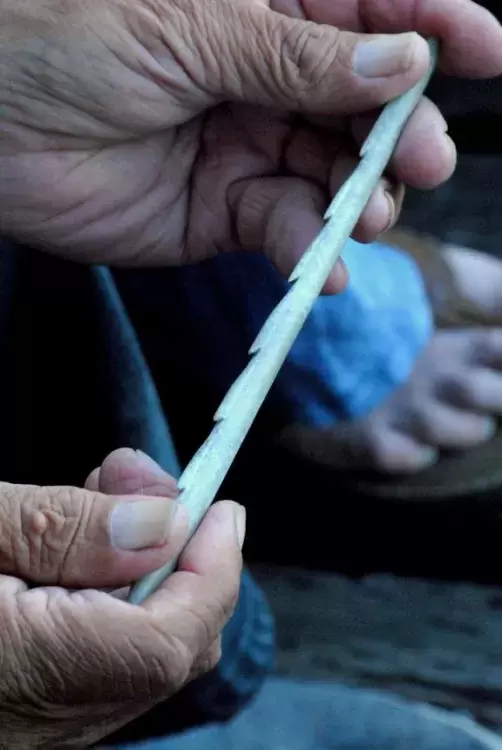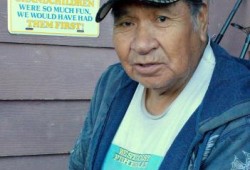Ghoo-Noom-Tuk-Tomlth sits in front of his house in the orange glow of a July sun as it recedes into the Pacific Ocean before him. The man who goes by the English name Ray Williams is one of the half-dozen year-round occupants of the traditional Mowachaht village site of Yuquot, located on the southwest shore of Nootka Island, off Vancouver Island’s west coast. As he stares into the bay Williams reflects on the land where he has lived for his whole life.
“I remember as a teenager there was 350 people here,” said the 75-year-old, who remembers the relocation of the Mowachaht Muchalaht First Nation reserve from Yuquot to Gold River in the 1960s. “The health authority asked me to move too and we said no. This is where I belong, this is where I live. This is our home.”
In his weathered hands Williams holds a small spear carved from bone, its serrated edges smoothed from the pressures of time. For Williams the tool is a testament to his people’s ancestral ties to the area; the last time he saw a similar object was during a Parks Canada sponsored archaeological dig in 1966, which unearthed evidence of habitation at Yuquot for at least 4,300 years. At one time over 1,000 people lived in Yuquot, which became the capital for 17 tribes in the Nootka Sound region.
Williams believes that hundreds of years ago, before the tallships of Britain’s Capt. James Cook arrived in the bay before him, the spear was attached to cedar rope for catching salmon by Yuquot’s pebbled shoreline.
“It’s hard to ever catch them now,” said Williams, recalling his youth on fishing boats. “When I was a teenager we used to always catch Coho on the back beach. There was a lot of Coho then in my time.”
Alan McMillan, an adjunct professor of archaeology at Simon Fraser University, has seen dozens of similar spears over the years that were excavated from ancient village sites along the west coast of Vancouver Island. He said the spear likely came out of the four metre-deep layer of earth that rises from Yuquot’s pebbled beach, a soil deposit that contains eons of human history.
“It’s a unilaterally barbed-fixed bone point,” said McMillan. “We tend to find them as broken fragments. That’s an unusual piece and it’s quite long, and it’s perfectly intact.”
“This is a beautiful piece, and it’s more complete than I’ve ever seen in an archaeological setting,” added Iain McKechnie, an assistant professor in the University of Victoria’s Department of Anthropology.
He had just finished an exploration of ancient Nuu-chah-nulth sites in the Broken Islands Group with fellow archaeologist Denis St. Claire and students from the University of Victoria.
“It’s one of a large range of bone tools that are used for all kinds or purposes,” observed McKechnie.
McMillan believes the spear could have been attached to a wooden shaft for hunting sea otter, mink, martin and other marine animals found by Yuquot’s shores. Such bone spears were used until European contact in the late 1700s, when they were replaced by metal tools.
“It’s on the end of a wooden shaft,” described McMillan. “These are like a spear with the barb to hold in place in the animal that’s been speared. The end that goes into the animal is almost spatulate, it’s a cutting end.”
“I have heard of darts with fixed points like this where the line is actually attached to the shaft,” added McMillan. “That’s another possibility.”
Besides visiting hikers traversing the Nootka Trail or the Mowachaht Muchalaht community’s annual week of summertime camping, Yuquot remains relatively quiet, leaving a buried wealth of links to Nuu-chah-nulth history in the site. From time to time these relics surface, explained Mowachaht Muchalaht Hereditary Chief Michael Maquinna.
“If anyone gets an exploration itch, it’s not hard for you to find something,” he said. “If you look at the banks of the village site you might find old bottles, beads maybe, trading beads.”
Ironically, the ancient spear was almost discarded after it was discovered this summer by a 10-year-old boy. Kolton Ivezich found the bone relic on the shoreline during a daytime visit to Yuquot. The lad was enjoying a fishing trip with his father over the Canada Day long weekend.
“He got away from me and I ended up finding him 20 minutes later scaling the rocks with this stick, I thought it was, in his hand,” recalled Kolton’s dad, Rob. “I actually gave him heck at first for carrying a stick on the rocks. He was climbing on the rocks with one hand.”
To save Kolton from hurting himself, Rob told his son to throw the stick away, despite the 10-year-old’s pleading to keep it.
“He threw it down to me and it went off into the rocks somewhere. I was almost going to leave it, but I know my son, he likes to collect things, so I went and got it,” Rob said. “He kind of wanted to bring it home for his collection. I said, ‘Well, I don’t think we can take this one home, bud.’”
When he realized the piece could be a First Nations tool with cultural significance, Rob approached a federal fisheries officer who was at the site that day. After the father and son brought the spear to Williams’ house, the lifelong Yuquot resident explained to them the importance of keeping the spear at the historic Mowachaht site.
“It’s important that when people visit here, even though there’s no signs put up, not to take anything out of here,” said Williams. “That’s our rule here.”
As an exchange, Kolton was given a prayer rattle carved from cedar with tiny pebbles inside from Yuquot’s beach. The rattle was made by Ray’s grandson Darrell Williams Jr., who moved from Campbell River two years ago to help Ray and his wife, Terry. Darrell’s son Isaiah also lives in Yuquot with the family.
Designed to ward off evil spirits, the rattle now hangs on the wall in Kolton’s room. The exchange helped inform the boy of the spear’s historical value.
“He didn’t realize the importance of it, but he certainly does now,” Rob said. “He was pretty happy to feel special for the day…A lot of the people were thanking him.”
Like the spear in his hand, as an elder Williams carries critical to ties to the northern Nuu-chah-nulth’s past. Besides himself, he knows of only six people who can speak Nuu-chah-nulth in the Mowachaht dialect. Williams also ate the last whale brought to Yuquot after it was hunted in the 1940s.
“A lot of people still don’t understand us yet, and it’s going to take them another 200 years more to understand us,” he said. “It’s going to take a long, long time. We need to have more people talk, talk in museums, schools - wherever they can talk, wherever they are allowed to talk.”
An important part of this understanding is recognition of Nuu-chah-nulth people’s right to fish in their waters, said Maquinna. He noted the importance of recent court decisions that give his people the legal right to support themselves through fishing.
“It’s a livelihood, it’s not a privilege. It’s more of a need to have our families survive throughout the day,” said Maquinna. “Hopefully someday we’ll have homes out here again and thrive in our fishing industry.”
Williams plans to bring the spear to a future tribal fisheries meeting.
“I want to tell the people that this is an important artifact from the Mowachaht people; that it proves our way of life, which leads to our fishing rights in our territory,” he said. “Keeping this and having it brought to me is very important because it proves we’re here for a reason: to protect Maquinna Hahoulthee, protect his land.”









